An event recap:
We were thrilled to invite the organisers of the Creativity Research Network (CRN) at our monthly NeuroArt Nexus to share with us common myths about creativity, drawing from their experiences as scientists, artists, and hosts of a global network on creativity research. This article gives a brief overview of the vast topics covered by CRN in this fascinating talk.
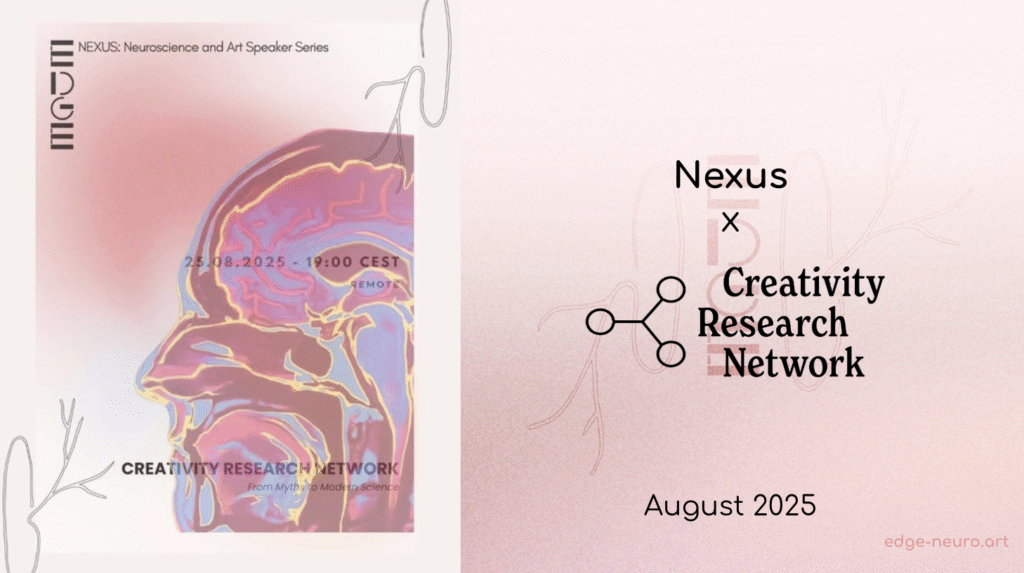
The NeuroArt Nexus is a monthly series of talks and community gatherings that bring together people interested in topics in art, neuroscience, and a blend of the two. Hosted either online or in person, the program features inspiring speakers, open discussions, and informal networking. Free for EDGE members and open to the public, the Nexus highlights diverse perspectives in science and the arts and showcases projects by EDGE members.

The Creativity Research Network (CRN) was founded by an international team of scholars who share a commitment to understanding creativity across disciplines and contexts. Bringing together diverse perspectives, the network’s co-founders include Kaile Smith (The Graduate Center, City University of New York, USA), Matteo Antona (University of Bristol / University of Bath, UK), Sarah O’Meara (University College Dublin, Ireland), and Stephanie Miller (University of Vienna, Austria). Their collective vision, to create a global platform where ideas, methods, and insights into creativity can converge, strongly mirrors EDGE’s vision for an international interdisciplinary community.
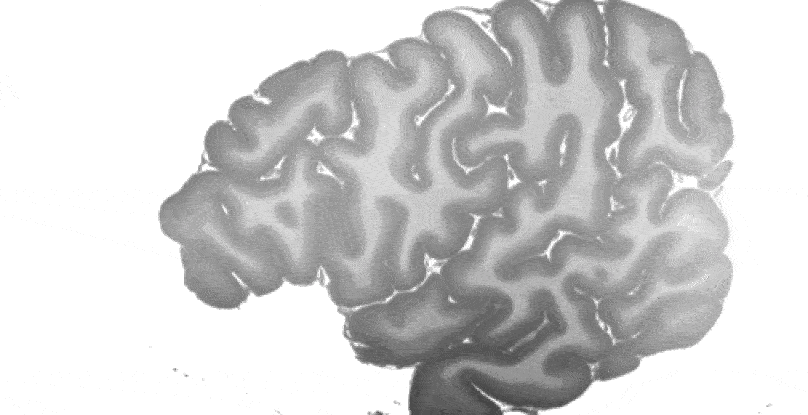
In their usual clear and engaging way, the CRN team walked us through what creativity actually means by guiding us through some of the most common myths surrounding it. Drawing on the work of Runco & Jaeger (2012) and Guilford (1967), they say that yes, creativity is about elements of novelty and innovation, but it also must be relevant and appropriate to the task at hand. They recognise creativity as a process, not an outcome, and that most people exhibit different levels of creative behaviour based on the circumstances, personality, cognitive, and motivational traits.

Some of the myths that CRN explored:
1) Children are more creative than adults.
After we all voted on whether we thought this was true, they explained that children and adults have different types of creativity; the answer requires us to examine the assumptions of what defines it. For example, it depends heavily on the model used. The Four-C’s model of creativity proposed by Kaufman & Beghetto (2009) catagorises people’s creative acts based on their context for new ideas and implementation, and their socioeconomic impact. However, this framework may not fully capture children’s creativity, as it privileges expertise and broader impact over the personal novelty and learning that characterize young people’s creative development. Since children are known to be fountains of ideas, so socioeconomic value can’t be the whole story (see table from CRN presentation below).
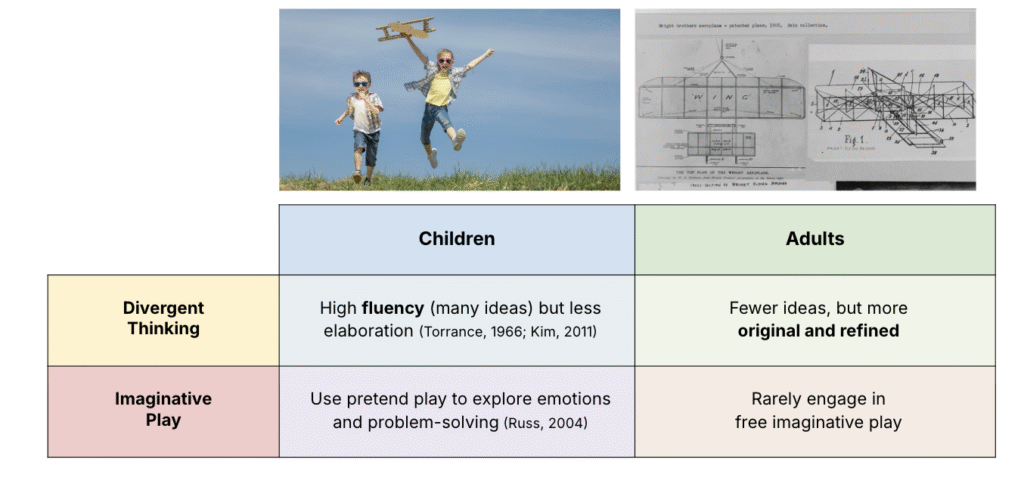
2) Creativity comes from the right side of the brain.
We sometimes hear people described as left brained or right brained, but how much truth is there to this?
Turns out, very little.
So where does this pervasive myth come from?
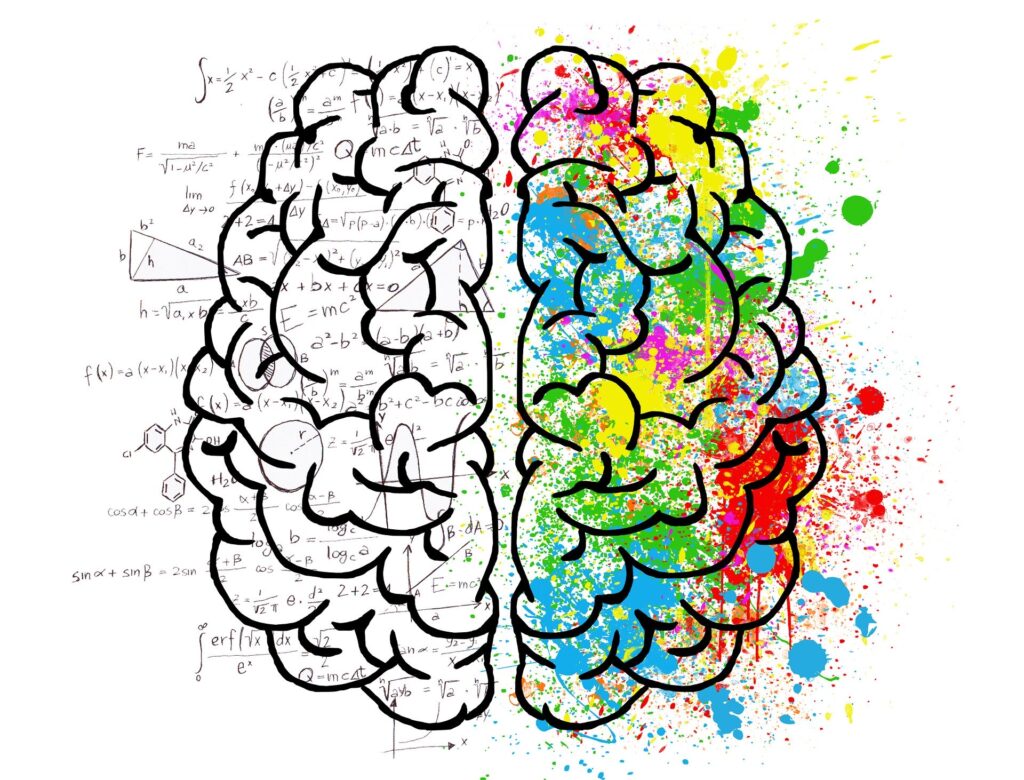
CRN explains that although the brain is not functionally symetrical, the processes governing creativity come from networks the whole brain over. This myth is likely to have indirectly come from a neurosurgeon Joseph Bogan in the 1970’s who saw that primary analytic/language areas being located in the left hemisphere. It was later incorrectly inferred that the right side must have ‘something’ too!
The team then used this opportunity to cover some of the key network dynamics in creativity; the Default Mode Network and the Central Executive Network. Research shows that creativity depends on the brain’s ability to flexibly switch between different networks.

The Executive Control Network helps us stay focused, inhibit distractions, and retrieve useful knowledge, while the Default Mode Network supports mind-wandering, idea generation, and mental simulation. Together, these systems allow us to move between divergent thinking (coming up with many possible ideas) and convergent thinking (narrowing them down to the best solution) (Chrysikou et al., 2023; Beaty et al., 2015, 2019; Chen et al., 2025; Lucini et al., 2025).
3) Creative people are more likely to have mental illness than the general population.
Unfortunately, we can all recall examples of famous creatives who succumbed to their struggles with mental illness and addiction. Many of us hold on to the trope of the tortured artist, but does art require suffering?
Digging into the genetics of it, Kaile Smith from CRN talked through how large genetic studies show that people in creative professions are slightly more likely to carry variants linked to schizophrenia or bipolar disorder, but “these explain only a tiny fraction of creative ability”. In fact, if the gap between “least creative” and “true artist” were a mile, genes account for just 13 feet. Creativity follows an inverted-U pattern: mild traits connected to creativity, like flexible thinking, emotional intensity, or perfectionism, may help insights, but severe mental illness usually hinders creativity.
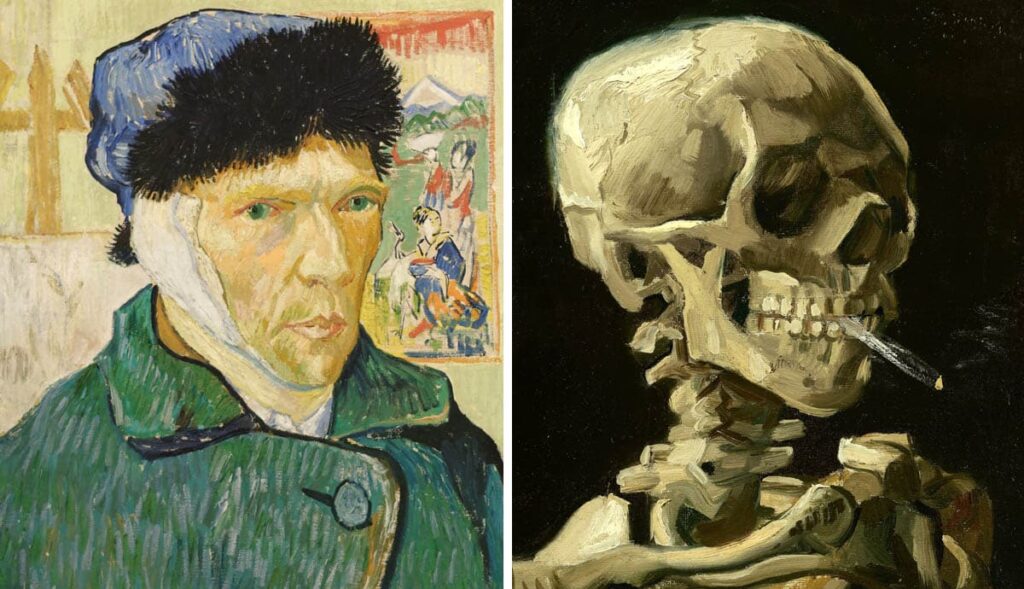
This connects to shared vulnerability models, the idea that certain traits (like cognitive disinhibition, emotional volatility, or neural hyperconnectivity) can feed into either creativity or mental illness. With protective factors such as high IQ, strong working memory, and cognitive flexibility, these traits can fuel creativity; without them, they may increase vulnerability to mental illness.
Importantly, most highly creative people are mentally healthy.
But it goes deeper than that, not only are creative people usually mentally healthy, creative practice can actually improve the quality of life. Kaile Smith highlighted some of her fantastic new research with a colleague (Smith and Drake, 2025), which looked at the positive effects of daily creative practice. They found that being creatively active actually boosts many well-being scores such as positive emotions, interpersonal relationships, meaning making, and sense of acccomplishment, while reducing negative emotion scores!
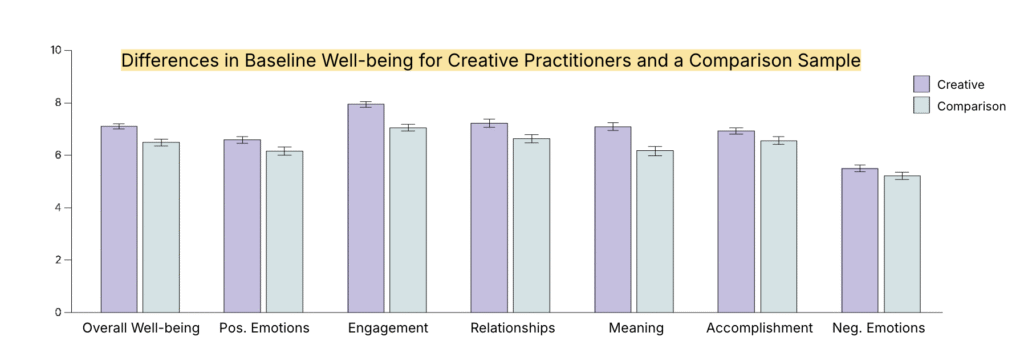
Do you consider yourself creative?
One of the key traits CRN linked to creativity is Openness to Experience. People who score high on this dimension tend to be curious, imaginative, and drawn to new ideas or experiences. Psychologists describe it as spanning several areas:
- Emotion & Motivation: a natural curiosity and desire to explore.
- Thinking/cognition: an inclination toward imagination, abstract thought, and intellectual engagement.
- Social Expression: a comfort with nonconformity and openness to different perspectives.
- Self-Regulation: the ability to get deeply absorbed in ideas and remain comfortable with uncertainty.
Researchers like McCrae & Costa (1999), DeYoung and colleagues (2012), and Feist (1996) have all highlighted how these traits help shape the creative spectrum.
‘Creativity is the connecting and rearranging of knowledge in the minds of people, who allow themselves to think flexibly––to generate new, often surprising ideas that others judge to be useful.’ –– Paul E PIsek
The August 2025 NeuroArt Nexus with the Creativity Research Network reminded us that creativity is neither child’s play, right-brain magic, nor a product of suffering, but a complex, dynamic process shaped by networks in the brain, personality traits, and life experiences. The CRN team succinctly broke down myths, showed us how creativity operates across contexts, and highlighted how daily creative practice can enrich wellbeing. At its heart, creativity is about openness, flexibility, and the ability to connect ideas in meaningful ways. And, as CRN’s work makes clear, it’s something we all participate in and not a gift reserved for a few!
CRN runs a monthly reading club focusing on creativity, arts, and aesthetics. Each month, they meet on Zoom to discuss, debate, and explore the ideas sparked by a selected paper in an open and welcoming space. If you want to learn more about the Creativity Research Network and their fascinating work, check out their website and join one of their upcoming meetings!
